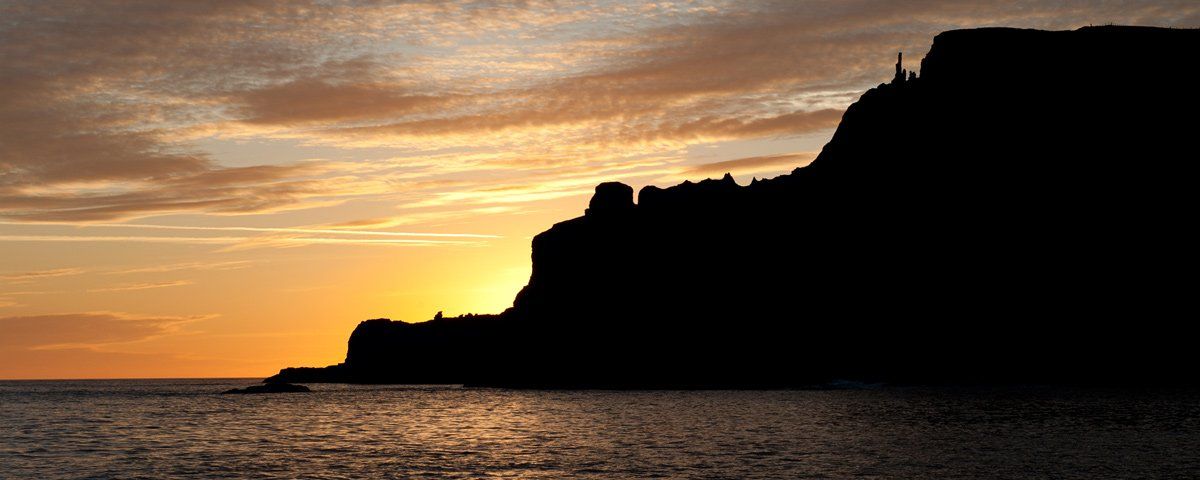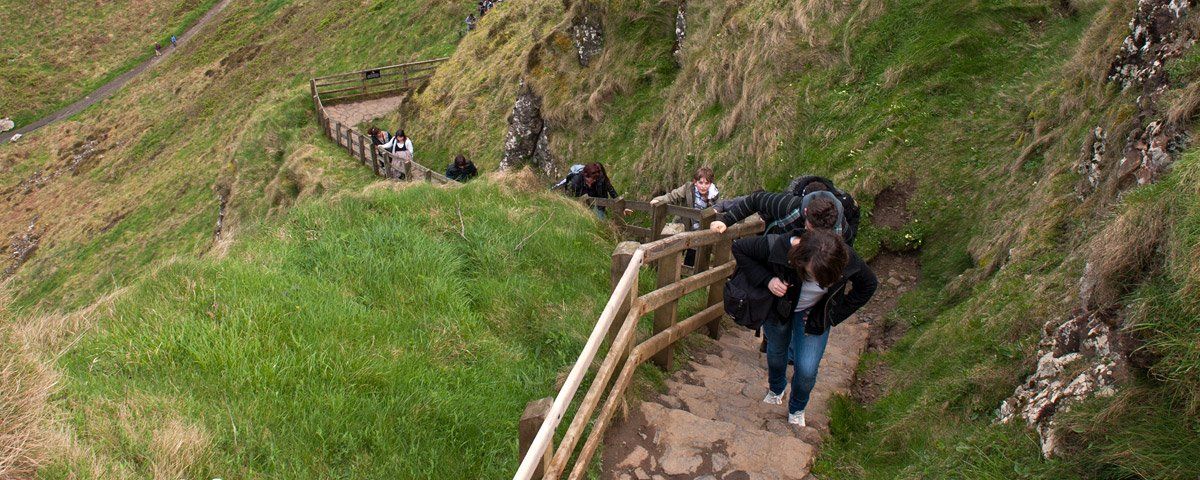You can walked from here to Ballintoy via the clifftop path, the visible lower mid cliff path is permanently closed from Port Reostan due to slope failures (rockfalls) which destroyed the path at several locations. The red layers of Laterite either side of Port na Spaniagh extends into Port Reostan and it is this layer, sandwiched between two harder basaltic layers which is prone to weathering and in turn leads to slope failure. Portcoon (Narrow Harbour) is famous for its sea cave which extends some two hundred yards, with tales of smuggling and ghostly pipers it was a popular spot for Victorian visitors who would hire local boatmen to take them round from the Brenther in Portnaboe or Black Rock boat slip below Runkerry House.
In Portnaboe (Port of the Cow) you will find remains of low stone walls, several theories exist as to their purpose and perhaps to a degree, all three are correct - one is that they were built to pen sheep or cattle - another that they were used to dry seaweed harvested from the shore, the third and most intriguing, is that they were built by Vikings who wintered here. It is known that Vikings used their boats when wintering, they would build a low stone wall in the shape of the hull, the boat would then be turned upside down and secured down with ropes, providing an excellent waterproof shelter. The Vikings are well documented as coming here in small 'hit and run' raiding parties, then later with fleets and eventually they made land bases in attempts to conquer the country.
In Portnaboe there are two intrusive volcanic dykes running out to sea, one of them is aptly named the 'Camel's Back'. The foreshore around the causeway has claimed many ships, in 1890 the schooner 'William & Mary' foundered on rocks between Portnaboe and Portcoon, en route from Maryport, Cumbria to Letterkenny, Donegal. Port Ganny sweeps round from the Great Stookan to the Causeway, if you had visited here sixty years ago, you would have encountered many local people with their crafts and gifts set out before them. They sold a range of handmade and collected items including soapstone carvings (metamorphic rock with a soapy feel and the characteristic mineral of Talc) and refreshments. They were all systematically removed when the National Trust took over.
Local people would also offer a guided tour of the Causeway Stones with a bit of blarney. At one time there was a ban punishable by a fine for selling alcohol without a license, the old ladies of the causeway found a way around this law, they sold water in a glass and then poured in the spirit for free. Looking back to the Great Stookan, there is a rock whose silhouette, especially as twilight falls resembles one of these old ladies walking up the steep incline - known locally as the 'Granny's Rock'. The causeway has a fascinating array of stones and amongst them you will find many interesting places including the 'Wishing Chair' which has been sat on many famous people including kings and queens.
At daylight she was lying partly broken up in the bay, accounts reported that there was no-one on board the ship and no bodies found in the bay, the logbook had no records for several days before she was lost, the crew were assumed drowned. Other ships that have foundered in this area include 'Abraham & Ann' 1824, and the 'Diligence' in 1839. Looking across to the far side of Port Noffer and accessible by the lower cliff path is the impressive 'Giant's Organ' - tall hexagonal basalt columns set into the steep grassy slope - the Shepherd's path connects here to the upper cliff walk. The lower cliff path into Port Reostan is permanently closed. Lacada Point is where the Spanish Galleass the 'Girona' sank in 1588 with the loss of over 1200 Spanish sailors and soldiers from the ill-fated Armada.
About 100 feet up the path near the 'long step', Mary slipped, lost her balance and tumbled back down and disappeared. The two boys climbed back down and found her lying unconscious at the bottom. They managed to get her up the path and round to the Causeway where she was taken to her father's house at Tonduff, she died never having regained consciousness. Runkerry house at Runkerry Point was once part of the estate of the Macnaghtens of Dunderave. it was built in the early 1860s by Sir Edward Macnaghten, the fourth Baronet. In 1951 Sir Malcolm Macnaghten donated Runkerry House to the Northern Ireland government for pubic use.
It was used for many years as a retirement home and later as a Residential Activity Centre and Rehabilitation Unit. It closed in 1996 and without any consultation with the community was sold at Public Auction to Seaport Investments Limited. The sale caused controversy regarding the moral 'right of sale' of a charitably donated property. After its purchase, the Talon Group Inc (website now down but registered in Scottsdale, Arizona) announced the development of Runkerry House as follows: Runkerry Hotel and Golf Club, Bushmills, Northern Ireland 'Talon is a partner in the development of a meeting, spa and golf resort in Northern Ireland. This facility will offer 5-star accommodation and a world-class golf course.
The Hotel and Golf Club never materialized but Runkerry House underwent enlargement with landscaping and development in keeping with the old building. Another issue regarding a 'permissive' right of way through part of the property became the focus of a court case between local walkers and Seaport Investments Limited - who won the case. A track is believed to have existed to Black Rock salmon station and recorded as being used by local boatmen before the turn of the century. There are echoes here of another famous 'right of way' court case which involved access to the Causeway Stones, after first losing the case, the High Court in Dublin overturned the ruling when evidence was produced proving that the maintenance for the right of way had been contracted by Council.










